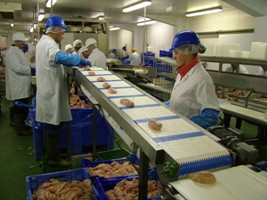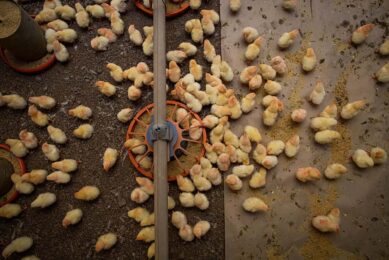EU poultry industry slightly optimistic

The dioxin shock did not hurt the European poultry meat producers as much as one expected. After a small dip consumers went back to normal purchasing patterns. Nevertheless, 2011 will be an interesting year taking increasing feed prices and the implementation of the food safety and new welfare rules into account.
By Wiebe van der Sluis
The European poultry sector in 2010 showed a positive trend concerning a continuation of production growth and an upward trend in price (Figure 1 and Table 1). Poultry meat production crossed the 11,500,000 tonne barrier and forecasts predict a slow prolongation of this development. As a consequence imports dropped (Table 2), while export figures showed a substantial increase (Figure 2).
A major victim of the import drop was Brazil, which saw its imports to the EU declining by 15%. The new export markets including Hong Kong (+80%) increased their share remarkably. Russia temporarily showed a higher interest in EU leg meat (+14%) due to the ban on frozen poultry meat from the USA. The EU poultry meat industry expects that this interest will fade away as soon as Russia will be able to fill up the gap with its own products. The industry there is still investing heavily in expanding domestic production. Five years ago self-sufficiency for poultry meat in Russia was only 55%, while the expectation is that this figure today will be close to, or just over, 84%.
Dioxin effect marginal
Before the turn of the year the expectations for 2011 were slightly optimistic despite the fact that the price of soy and some other feed ingredients were on the increase. The dioxin scam in Germany however, initially changed the outlook dramatically. Media attention scared consumers so they stopped buying pork and poultry products.
Before the turn of the year the expectations for 2011 were slightly optimistic despite the fact that the price of soy and some other feed ingredients were on the increase. The dioxin scam in Germany however, initially changed the outlook dramatically. Media attention scared consumers so they stopped buying pork and poultry products.
Fortunately, most consumers returned to the shops to buy poultry meat after realising that dioxin levels in poultry meat proved to be safely below the accepted EU level of 2pg/g fat in meat. The egg market however suffered more and longer from the disaster, even though nearly all eggs entering the food chain measured well below the EU maximum level.
This level is often the subject of discussions, because an individual has to eat at least 200 eggs a day for quite some time to get near to a dangerous dioxin level, while in addition the level is only valid for eggs produced at a standard type farm. Biologically produced (eco) poultry meat and eggs can be sold with higher levels, since it has proven almost impossible to produce bio eggs and meat with low dioxin levels. Dutch research showed that at least 15% of all poultry kept outdoors, surpass the maximum EU-level for standard production.
Back to normal
After the first official information was released about the minimum effect the dioxin found in feed had on meat produced at the suspected farms, the EU Poultry meat market recovered quickly. Poultry meat remains a popular meat among EU consumers. Nevertheless, the 2010 consumption level is expected to be below the 2009 level. Specialists explain the small step backwards as the result of a return to the normal consumer purchasing pattern from before the economic crisis.
After the first official information was released about the minimum effect the dioxin found in feed had on meat produced at the suspected farms, the EU Poultry meat market recovered quickly. Poultry meat remains a popular meat among EU consumers. Nevertheless, the 2010 consumption level is expected to be below the 2009 level. Specialists explain the small step backwards as the result of a return to the normal consumer purchasing pattern from before the economic crisis.
During those ‘crisis’-days consumers lowered the intake of the more expensive pig meat and beef, by replacing it for poultry meat.Now that people have learned to deal with the new economic situation they slowly return to their traditional eating habits.
Salmonella reduction
In 2010, the EU poultry industry improved the salmonella status. Most countries have a functioning monitoring system in place, resulting in decreasing infection levels. This stimulates the industry as well as the authorities to work hard on implementing systems to produce without the use of antibiotics.
In 2010, the EU poultry industry improved the salmonella status. Most countries have a functioning monitoring system in place, resulting in decreasing infection levels. This stimulates the industry as well as the authorities to work hard on implementing systems to produce without the use of antibiotics.
Much energy is spent by producers as well as researchers to find ways to minimise the use of antibiotics, both preventive and curative use. Several producers have proven that excellent results can be obtained without the use of any antibiotic substance. Their experience is a challenge for many to follow.
Limits on bird density
The year 2011 will be the year in which all EU countries have to meet the new broiler welfare rule. Directive 2007/43, came into force on June 30, 2010,having a dramatic impact on the number of birds kept per house. It lays down rules for maximum stocking density, drinking facilities, litter, feeding, ventilation, heating, light, noise, cleanliness and surgical interventions, record keeping and training of stockmen.
The year 2011 will be the year in which all EU countries have to meet the new broiler welfare rule. Directive 2007/43, came into force on June 30, 2010,having a dramatic impact on the number of birds kept per house. It lays down rules for maximum stocking density, drinking facilities, litter, feeding, ventilation, heating, light, noise, cleanliness and surgical interventions, record keeping and training of stockmen.
The directive states that Member States shall ensure that the maximum stocking density in a holding or a house of a holding does not at any time exceed 33kg/m2. When meeting specific requirements regarding housing conditions, ammonia (max 20 ppm) and carbon dioxide (max 3000 ppm) level, and flock management, the stocking density can be increased up to 39 kg/m2. Producers may add an additional 3 kg when showing perfect stockmanship. They then have to prove that they have in at least seven consecutive subsequently checked flocks from a house a cumulative daily mortality rate below 1% plus 0.06% multiplied by the slaughter age of the flock in days.
Good stockmanship pays off
Although the welfare directive is in force, many producers still do not know how many birds they are allowed to have in their facility. House measures are clear (either provided by the owner or by independent measurements) but it now shows that authorities in various EU countries deduct the floor space with the space they believe feeders and drinkers take. This deduction can be a few percent which may mean a few hundred birds less per house than what the producer had hoped for. This confusion or lack of clarity results in variations in the implementation of the directive and a distortion of competition within the EU.
Although the welfare directive is in force, many producers still do not know how many birds they are allowed to have in their facility. House measures are clear (either provided by the owner or by independent measurements) but it now shows that authorities in various EU countries deduct the floor space with the space they believe feeders and drinkers take. This deduction can be a few percent which may mean a few hundred birds less per house than what the producer had hoped for. This confusion or lack of clarity results in variations in the implementation of the directive and a distortion of competition within the EU.
Similar disruptions can be expected regarding interpretation, monitoring and controlling of other aspects of the directive. Most important here could be the use of a footpad lesion score as an indicator for litter quality and stockmanship. Field results however show that good stockmanship, quality feed and the use of high quality drinkers may dramatically reduce footpad lesions as well as the severity of the lesions.Dutch research showed that the presence of drip cups dramatically reduces the presence of severe footpad lesions. In a comparison at farm level between birds raised in the presence and absence of drip cups it was shown that at day 21 about 63% of the birds raised without drip cup had severe lesions, while those raised without showed only 41% severe lesions. At day 33 the percentages were 95 and 78 respectively.
These issues as well as many other common aspects dealing with poultry production show that nothing can be taken for granted. In order to meet new regulations and consumer demands EU producers do have to evaluate their operation again and again to be sure that they will remain competitive.
Join 31,000+ subscribers
Subscribe to our newsletter to stay updated about all the need-to-know content in the poultry sector, three times a week. Beheer
Beheer








 WP Admin
WP Admin  Bewerk bericht
Bewerk bericht